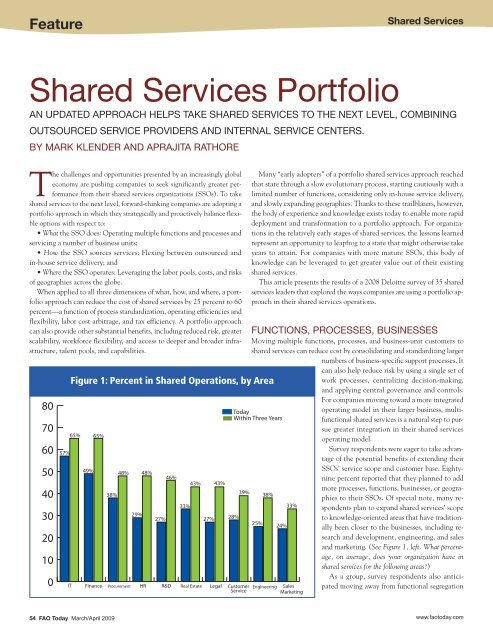March/April 2009 www.FAOToday.com
March/April 2009 www.FAOToday.com
March/April 2009 www.FAOToday.com
You also want an ePaper? Increase the reach of your titles
YUMPU automatically turns print PDFs into web optimized ePapers that Google loves.
Feature<br />
Shared Services<br />
Shared Services Portfolio<br />
AN UPDATED APPROACH HELPS TAKE SHARED SERVICES TO THE NEXT LEVEL, COMBINING<br />
OUTSOURCED SERVICE PROVIDERS AND INTERNAL SERVICE CENTERS.<br />
BY MARK KLENDER AND APRAJITA RATHORE<br />
The challenges and opportunities presented by an increasingly global<br />
economy are pushing <strong>com</strong>panies to seek significantly greater performance<br />
from their shared services organizations (SSOs). To take<br />
shared services to the next level, forward-thinking <strong>com</strong>panies are adopting a<br />
portfolio approach in which they strategically and proactively balance flexible<br />
options with respect to:<br />
• What the SSO does: Operating multiple functions and processes and<br />
servicing a number of business units;<br />
• How the SSO sources services: Flexing between outsourced and<br />
in-house service delivery; and<br />
• Where the SSO operates: Leveraging the labor pools, costs, and risks<br />
of geographies across the globe.<br />
When applied to all three dimensions of what, how, and where, a portfolio<br />
approach can reduce the cost of shared services by 25 percent to 60<br />
percent—a function of process standardization, operating efficiencies and<br />
flexibility, labor cost arbitrage, and tax efficiency. A portfolio approach<br />
can also provide other substantial benefits, including reduced risk, greater<br />
scalability, workforce flexibility, and access to deeper and broader infrastructure,<br />
talent pools, and capabilities.<br />
80<br />
70<br />
60<br />
50<br />
40<br />
30<br />
20<br />
10<br />
0<br />
57%<br />
Figure 1: Percent in Shared Operations, by Area<br />
65% 65%<br />
49% 48% 48%<br />
38%<br />
29%<br />
27%<br />
46%<br />
33%<br />
Many “early adopters” of a portfolio shared services approach reached<br />
that state through a slow evolutionary process, starting cautiously with a<br />
limited number of functions, considering only in-house service delivery,<br />
and slowly expanding geographies. Thanks to these trailblazers, however,<br />
the body of experience and knowledge exists today to enable more rapid<br />
deployment and transformation to a portfolio approach. For organizations<br />
in the relatively early stages of shared services, the lessons learned<br />
represent an opportunity to leapfrog to a state that might otherwise take<br />
years to attain. For <strong>com</strong>panies with more mature SSOs, this body of<br />
knowledge can be leveraged to get greater value out of their existing<br />
shared services.<br />
This article presents the results of a 2008 Deloitte survey of 35 shared<br />
services leaders that explored the ways <strong>com</strong>panies are using a portfolio approach<br />
in their shared services operations.<br />
FUNCTIONS, PROCESSES, BUSINESSES<br />
Moving multiple functions, processes, and business-unit customers to<br />
shared services can reduce cost by consolidating and standardizing larger<br />
numbers of business-specific support processes. It<br />
can also help reduce risk by using a single set of<br />
Today<br />
Within Three Years<br />
IT Finance Procurement HR R&D Real Estate Legal Customer Engineering Sales<br />
Service<br />
Marketing<br />
43%<br />
27%<br />
43%<br />
28%<br />
39%<br />
25%<br />
38%<br />
24%<br />
33%<br />
work processes, centralizing decision-making,<br />
and applying central governance and controls.<br />
For <strong>com</strong>panies moving toward a more integrated<br />
operating model in their larger business, multifunctional<br />
shared services is a natural step to pursue<br />
greater integration in their shared services<br />
operating model.<br />
Survey respondents were eager to take advantage<br />
of the potential benefits of extending their<br />
SSOs’ service scope and customer base. Eightynine<br />
percent reported that they planned to add<br />
more processes, functions, businesses, or geographies<br />
to their SSOs. Of special note, many respondents<br />
plan to expand shared services’ scope<br />
to knowledge-oriented areas that have traditionally<br />
been closer to the businesses, including research<br />
and development, engineering, and sales<br />
and marketing. (See Figure 1, left. What percentage,<br />
on average, does your organization have in<br />
shared services for the following areas?)<br />
As a group, survey respondents also anticipated<br />
moving away from functional segregation<br />
54 FAO Today <strong>March</strong>/<strong>April</strong> <strong>2009</strong><br />
<strong>www</strong>.faotoday.<strong>com</strong>
















